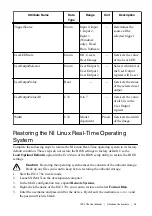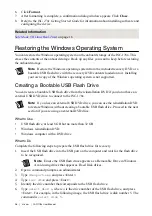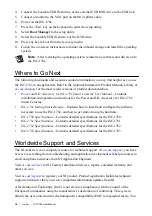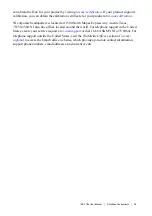
windows, the ambient light can vary significantly with weather. Also, standard fluorescent
lighting flickers at a rate that is perceivable by the ISC-178x. In these situations, the ambient
light must be overridden with a dedicated light source to ensure reproducible results.
The Lighting Strobe starts after the Trigger Delay is satisfied. Use the Exposure Delay if your
lighting source requires time to reach a stable intensity so that your images are consistent and
your lighting does not fluctuate. The Exposure Delay can only be specified in units of time,
and defaults to a value of 0. The Exposure Delay can be adjusted by setting the Exposure
Delay control in Vision Builder AI, setting the Exposure Delay attribute in LabVIEW, or by
setting the Exposure Delay in the attribute tree in MAX. The exposure begins once the
Exposure Delay is satisfied. Both the Lighting Strobe and the Exposure signals end once the
Exposure Time is satisfied.
Related Information
Determining the Maximum Frame Rate
Image Readout
The image readout phase begins immediately following the completion of the image exposure
time. During image readout, the sensor transfers the acquired image data to the CPU of the
ISC-178x.
The image readout duration is primarily dependent upon the image size and the image
decimation because these settings directly influence the amount of data that must be
transferred. The length of time required for the image readout directly affects the maximum
frame rate that can be achieved because only one image can be transferred at a time. There can
never be an exposure that ends during the image readout for the previous image. The
relationship between the triggering, exposure, and readout of the image is determined by the
Trigger Overlap feature.
Related Information
Determining the Maximum Frame Rate
on page 22
Trigger Overlap
The Trigger Overlap feature determines whether to allow the exposure phase of a triggered
image acquisition to occur while the previous image is still being transferred to the host. If
Trigger Overlap is disabled, the exposure phase and the image transfer phase will occur
sequentially. If the exposure phase ends before the previously acquired image is transferred to
the host, enabling Trigger Overlap can lead to dropped frames. If, however, the exposure phase
ends after the previously acquired image is transferred to the host, enabling Trigger Overlap
can increase the speed of your application.
When Trigger Overlap is disabled, the start of the exposure phase is highly deterministic
because the exposure and image readout occur sequentially. When Trigger Overlap is enabled
and the exposure begins during the readout of the previous image, the exposure signal must be
synchronized with the sensor. This introduces additional offset and jitter to the start of the
exposure.
ISC-178x User Manual
|
© National Instruments
|
25
Summary of Contents for ISC-1783
Page 1: ...ISC 1783...
















































